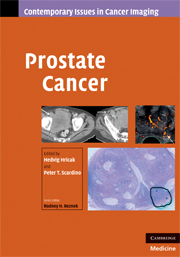Book contents
- Frontmatter
- Contents
- Contributors
- Series Foreword
- Preface
- 1 Anatomy of the prostate gland and surgical pathology of prostate cancer
- 2 The natural and treated history of prostate cancer
- 3 Current clinical issues in prostate cancer that can be addressed by imaging
- 4 Surgical treatment of prostate cancer
- 5 Radiation therapy
- 6 Systemic therapy
- 7 Transrectal ultrasound imaging of the prostate
- 8 Computed tomography imaging in patients with prostate cancer
- 9 Magnetic resonance imaging of prostate cancer
- 10 Magnetic resonance spectroscopic imaging and other emerging magnetic resonance techniques in prostate cancer
- 11 Nuclear medicine: diagnostic evaluation of metastatic disease
- 12 Imaging recurrent prostate cancer
- Index
- Plate section
- References
8 - Computed tomography imaging in patients with prostate cancer
Published online by Cambridge University Press: 23 December 2009
- Frontmatter
- Contents
- Contributors
- Series Foreword
- Preface
- 1 Anatomy of the prostate gland and surgical pathology of prostate cancer
- 2 The natural and treated history of prostate cancer
- 3 Current clinical issues in prostate cancer that can be addressed by imaging
- 4 Surgical treatment of prostate cancer
- 5 Radiation therapy
- 6 Systemic therapy
- 7 Transrectal ultrasound imaging of the prostate
- 8 Computed tomography imaging in patients with prostate cancer
- 9 Magnetic resonance imaging of prostate cancer
- 10 Magnetic resonance spectroscopic imaging and other emerging magnetic resonance techniques in prostate cancer
- 11 Nuclear medicine: diagnostic evaluation of metastatic disease
- 12 Imaging recurrent prostate cancer
- Index
- Plate section
- References
Summary
Introduction
Prostate cancer has attracted a great deal of resources and effort in the scientific community not only because it is the most common malignancy and the third leading cause of cancer-related mortality in American men [1], but also because of its complex, often baffling nature. It demonstrates a wide clinical spectrum, from indolent disease that the patient will die with, rather than from, to highly aggressive disease that threatens the patient's life. One of the most important questions in managing prostate cancer, therefore, is how to stratify patients by their disease characteristics in order to design appropriate, individualized treatment plans. The use of imaging, which is an integral part of prostate cancer management, should also be guided by the patient's risk category, as determined by the patient's age, prostate-specific antigen (PSA) level, Gleason score, and number of positive biopsy cores [1].
In recent years computed tomography (CT) has undergone substantial technical improvements. With the introduction of high-speed multidetector helical scanners, it is now possible to acquire a CT study with high spatial resolution in a very short time. However, compared to magnetic resonance imaging (MRI), CT has poor soft-tissue resolution in the pelvis and therefore is not the modality of choice for evaluating primary prostate cancer.
It has been shown that in patients with low-risk prostate cancer the likelihood of positive findings on abdominal/pelvic CT is extremely low [2, 3]. Therefore, it has been recommended that CT be reserved for the staging of prostate cancer in high-risk patients.
- Type
- Chapter
- Information
- Prostate Cancer , pp. 120 - 139Publisher: Cambridge University PressPrint publication year: 2008

